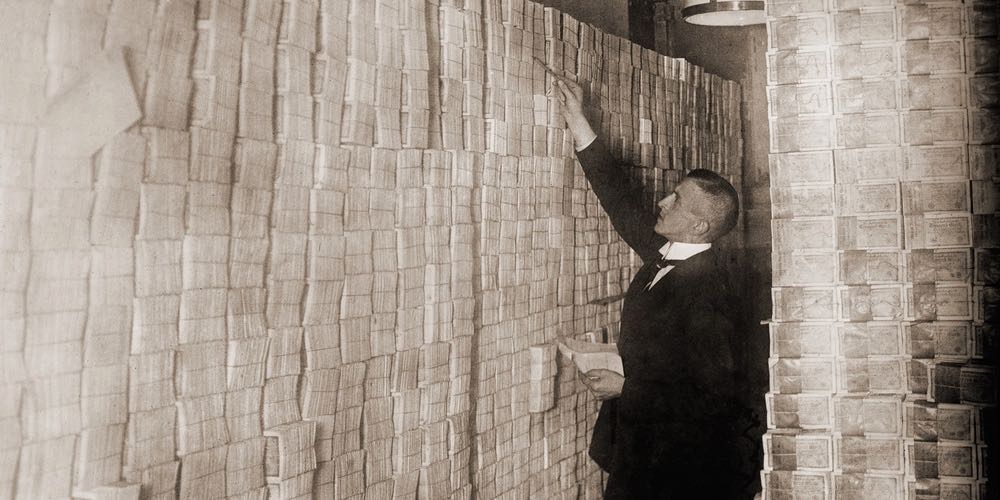Indexation helped Brazil cope with inflation until politicians' profligate ways were brought under control.
The Eternal Return of Price Controls
One of the privileges of a rich man is that he can afford to be foolish much longer than a poor man. And this is the situation of the United States. The financial policy of the United States is very bad and is getting worse. Perhaps the United States can afford to be foolish a bit longer than some other countries.
Ludwig von Mises
Americans have been rich and foolish for decades now, and it looks like it’s finally catching up to us. The Bureau of Labor Statistics places the all-items price index (CPI-U) for the end of March 2022 at an 8.5% increase over the previous 12 months, the largest it has been for 40 years (since January of 1982). With prices eroding purchasing power, not a few are wondering if we should take a crack at price controls. Hungary’s Prime Minister Viktor Orbán instituted price controls on certain grocery products, and some in the US are calling for targeted price controls as well: “By instituting temporary and product-specific price caps, the logic goes, the government could ensure that the poor don’t end up getting gouged.”
Price controls are government efforts to set a maximum or minimum price that a good or service can be exchanged for. When prices are rising or deemed excessive, maximum prices are the main concern, and governments may try to control them through price caps, wage freezes, or rent control. This is intuitively appealing. If prices are rising, why not ‘make’ them stay put?
The simplest answer is that we can’t: dollar prices are like the news. They tell you about something; they aren’t the thing itself. If we don’t like what we read in the news, changing the words on the page to say something better is just propaganda. And because falsified news, like a price control, isn’t truthful, it leads people to make bad decisions, damaging to them and to others. Ultimately, the only way to change news we don’t like is to get at what is causing the unpleasantness in the first place. In the case of runaway inflation, that cause is irresponsible management of the money supply.
Money Prices, Real Prices
No price is a price simply. The numbers one sees on a price tag are dollar amounts, which stand for quantities of goods that can be exchanged at a given time and place, under current conditions. If a gallon of milk is selling for $3.75, that represents perhaps about a gallon of gas, a half a pack of cigarettes, and two small bags of rice. The price of milk in terms of another good, such as gasoline, is called the real price. The real price of any good arises as a dynamic phenomenon from local conditions of availability (supply) and the capacity of the good to meet people’s needs relative to meaningful substitutes (demand). But it would be very difficult to do business or meet our needs if we had to think about every good in terms of every other. I can buy milk or two bags of rice, milk or one gallon of gas, and so forth.
The price in currency, the money price, references in a single number all the quantities of goods that can be exchanged for a gallon of milk. When we say that money is a medium of exchange, we mean that money itself isn’t the good being exchanged. People don’t want money for its own sake. But here is the important thing: because money prices are directly observed, and real prices only indirectly inferred, it’s easy to mistake the money price for the real price. Instead, a money price collapses information about local conditions of availability (supply) and need (demand), as well as the exchangeability of the good (via money) with all other goods into a single number. This is why I called the money price “news”: it’s an index of communication about underlying realities—realities that are vital for us to know about.
Suppose, then, a well-intentioned policymaker looks to freeze the money price of milk in the face of runaway inflation. Milk is becoming quite expensive, and he’s worried that desperate mothers won’t be able to afford it for their children. His concern is laudable! But if he takes this policy measure, he hasn’t succeeded in freezing the ‘price’ of milk at all. Milk is no more available than it was before, nor has there been any change in people’s need for milk. But the number people use to make plans about milk (the news!) has changed. What sorts of things might happen?
Fatally, price controls don’t make basic goods more accessible. They make them scarce.
Initially, the money price of milk relative to other goods declines. So now there is this one special good in the economy, a gallon of milk, which can be purchased at a weird discount. Economizing households will effectively look to purchase as much of this discounted good as possible by substituting milk for other goods in their regular consumption: more milk, less cream; more milk, less soda; more milk, less meat; and so forth. Ex-post, the real prices of other goods will adjust as households carry out this basic provisioning behavior, out of reach of policymakers even in a fully planned economy. Ripple effects arise in dairy markets, beverage markets, restaurant markets, and more. Households effectively find ways to buy gasoline, paper products, and entertainment with milk, indirectly, from the money saved on milk substitutions.
This points to a paradox in the world of price controls: policymakers tend to fix prices for goods that meet basic needs, or have a central role in household budgets. But by virtue of their centrality households can lean into them in ways that are hard to prevent—buying the fixed-price good because other things are getting more expensive. When all households and firms lean in together, predictably, price-controlled goods are snapped up wherever they can be found. Crippling shortages abound. And suppliers, if not subsidized, cease bringing price-controlled goods to market, compounding those shortages. Fatally, price controls don’t make basic goods more accessible. They make them scarce.
This might seem like an abstract mental exercise, but the children now starving in Venezuela are not an abstraction. Food shortages there are the direct result of Chavez’s price-controlled economy. Likewise, the devastating lines at the gas pump in 1973 were the consequence of Nixon’s 1971 Executive Order 11615 which aimed to provide for the “stabilization” of energy prices.
The term “price controls” is ironic, because they don’t really establish meaningful control of anything. Since only money prices can be ‘dictated,’ exchange (real) prices still float as households figure out the best way to provision themselves under new conditions. Suppose milk is frozen at $3.75 a gallon. To prevent shortages of milk, a policymaker will soon have to ‘control’ prices for half-gallons, and then all the natural milk substitutes: half-and-half, cream, almond milks, soy milks, oat milks, and so forth. Very few people will buy half-and-half if gallons of whole milk are much cheaper. Modest price controls quickly become immodest.
But this is intuitive. Price controls are only placed on the table as a policy choice when something is already out of control. Left in place long enough, policymakers are always forced to abandon them, or else ratchet up totalitarian administration of the economy. It was widely known that Hugo Chavez required his military to enforce his price controls. His successor, Nicolas Maduro, has implemented one ‘fair price’ measure after another, and routinely declares when Christmas will come for Venezuelans, who live with constant economic devastation. Like the old Soviet newspaper called Pravda (in Russian “truth”) the name ‘control’ rather announces defeat. Price controls are propaganda prices.
There is one more way we know they are propaganda. They are never applied to goods like stocks, where the wealthy make trades that capitalize on price changes. No—these meaningless and destructive ‘controls’ are applied to poor-man’s goods, food and energy, so cheap politicians can take credit for ‘helping’ while retaining their own ability to take advantage of fluid price movements.
Prices are Forward-Looking
Carl Menger used a great example to describe the nature of prices. “If the locks between two still bodies of water are opened, the surface will become ruffled with waves that will gradually subside until the water is still once more. The waves are only symptoms of the operation of the forces we call gravity and friction.” He went on to say that “The prices of goods…resemble these waves. The force that drives them to the surface is the ultimate and general cause of all economic activity, the endeavor of men to satisfy their needs as completely as possible, to better their economic positions.” According to Menger, prices, the quantities of goods actually exchanged, were nowhere near the most important feature of economic exchange. Rather, “prices are only incidental manifestations of [provisioning] activities,” symptoms of household planning and management, and not the substance. Prices don’t inhere in a good in any objective sense.
Consider a frontier exchange economy. Suppose a territorial governor has decreed that in exchange for a white rabbit fur, a trader can receive no more than two fox furs. The decree is designed to make white rabbit furs more affordable relative to common furs, like fox and coon. But in an exchange economy, the ‘control’ is meaningless unless all other exchanges are also specified. May a trader receive more than two coonskins in exchange for the white rabbit fur? What about a bolt of calico fabric? Five tins of coffee? And so forth?
What is the meaning of a price control in an exchange economy? Exactly nothing. Traders will simply execute more trades to achieve what provisions they need. So, if white rabbit furs are scarce because there are only a few white rabbits, or they are hard to catch in winter, and if white rabbit trappers would like to get four fox furs instead of two, they can instead ask for ten tins of coffee, which the local governor failed to mention, and which can be exchanged for four fox furs. The decree won’t matter. Traders will find a way to realize the real price of rabbit furs, because that price isn’t a single number: it’s a full menu of quantities of other goods.
If instead white rabbit trappers are forced to sell for only two fox furs, and to accept no other goods or services in exchange, we are in the world of propaganda prices, and milk that must sell at $3.75 when other prices are rising. The losers will be the trappers, the winners the first round of buyers of discount white rabbit furs, who will pay for coffee with the savings from rabbit furs. And after that, nobody will bring rabbit furs to market. Trapper shelves will be bare. When the governor figures out the mistake, he can add a new ‘control’ on tins of coffee, but he’ll need another one and another one to ‘control’ the full menu of quantities of goods that can be exchanged for white rabbit furs.
Runaway inflation under a centralized monetary authority is a policy choice of the planner, not an inexplicable feature of market forces.
This example may be simple, but it isn’t simplistic. How much should anything cost? As a matter of descriptive fact, prices emerge from mothers and fathers and caretakers looking to provision themselves and their dependents, relative to underlying conditions of scarcity and need. Quantities exchanged can vary daily, hourly, and even more frequently. In my own cottage industry, for example, you will pay more for a fresh loaf out of the oven hand-delivered ($12.50) than for yesterday’s loaf picked-up ($5). How much should a 1-kilo loaf of my neighborhood’s best sourdough cost? What about a white rabbit fur in northern Ontario in 1830 in a snowy January? The answer is that it depends, and it always depends, and it can only be intelligible to the traders.
Exchanges reflect local conditions and local alternatives. There’s no ‘one price’ for any single good in various locations over time: not even at the same retailer. A gallon of milk, or a gallon of gas, can have a dozen different prices in a single square mile. The fact is we don’t know exactly what things should cost, since price is relative to a million things. But we do know that current prices induce enterprising individuals to bring goods to market. Setting a cap on prices in the face of rising prices quells the very activity that a struggling market needs.
At any point in time, prices set the direction for the future, since prudence requires planning, or ‘pro-vision,’ and planning requires a best guess about what tomorrow’s efforts will bring. Today’s prices are factored into that best guess through the provisioning behavior of households and firms. Cap the prices and watch how many entrepreneurs conclude that delivering the product won’t be worth their while in the future. For this reason, sane nations committed to even a semblance of an enterprise-based economy have avoided these types of policy blunders. There are mercifully few examples to point to outside of explicitly totalitarian socialist regimes.
Inflation is a Policy Choice
In the final analysis, price controls are simply beside the point. Runaway inflation under a centralized monetary authority is a policy choice of the planner, not an inexplicable feature of market forces. Surely, for a given growth rate of money, supply shocks, or other productivity shocks can lead to transitory inflation as prices adjust to reflect lower output growth. But no matter what authorities say, runaway inflation, such as we are now facing, is a policy choice.
“There can be no secret way to the solution of the financial problems of a government” Mises said in 1958. “If it needs money, it has to obtain the money by taxing its citizens (or, under special conditions, by borrowing it from people who have the money). But many governments, we can even say most governments, think there is another method for getting the needed money; simply to print it.” He added, “But of course, the word ‘inflation’ [is] not used. The politician in power who proceeds toward inflation does not announce, ‘I am proceeding toward inflation.’ The technical methods employed to achieve the inflation are so complicated that the average citizen does not realize inflation has begun.”
Between March of 2020 and January of 2022, the US government spent about $5 trillion.
How big is $5 trillion? It is one-fifth the size of the public debt in 2020, and a quarter of the size of national output at the start of the pandemic—truly massive quantities which couldn’t have been anything but inflationary. Worse, since central banks have been operating within an experimental ‘quantitative easing’ framework since the 2008 financial crisis, the tools at their disposal to fight inflation are more limited. That didn’t seem like such a big tradeoff when inflation was a distant memory and the Philips curve appeared to be flattened. But the plain truth is this: central bankers have exactly no practice bringing inflation down under quantitative easing. Whatever they do, they will be making it up, and we must hope they get it right. In the meantime, let’s remain committed to prices that tell the truth, and policies that don’t lie.


